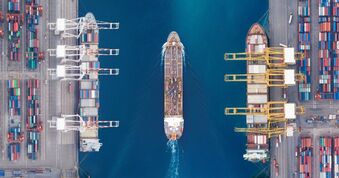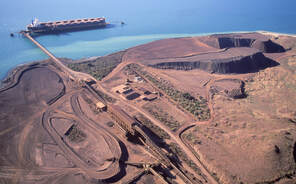Port Management |
Vessel Traffic Services |
Export Supply Chains |
|
Our members hold positions at multiple levels of Australian port infrastructure.
|
Our members design & operate vessel traffic services around Australia.
|
Exports comprise 88% of Australia's sea trade. Our experts understand the links between mine and customer.
|
Ports & Terminals
Just like an airport, a shipping port is a complex operation. Cargo vessels need to get in and out safely, and load and unload efficiently and quickly. The cargo vessel could be carrying containers (as for example at Port Botany or Melbourne), dry bulk such as iron ore at Port Hedland or Coal at Newcastle. Livestock exports perhaps at Darwin, Oil or Gas or other bulk liquids at many specialised bulk liquid berths in many ports, or passengers as in Sydney or with ferry traffic at Melbourne and Devonport.
Whatever the type of vessel, each movement must be scheduled, controlled, and safely executed. Each port will have a specialised set of procedures covering all aspects of entering or leaving port. These procedures are often mandated by International Conventions and governed by local laws and regulations. The Harbour Master runs the port operations and has ultimate responsibility. He or she will have responsibility for all shipping movements and the safe marking of dangers and the hydrographic surveying of the port.
Australia has 17 major seaports: Adelaide, Brisbane, Darwin, Burnie, Devonport, Fremantle, Geelong, Melbourne, Sydney (Port Botany), Port Kembla, Townsville, Dampier, Port Hedland, Gladstone, Hay Point, Newcastle, and Port Walcott.
The 17 major ports vary in their scale of operation and characteristics. The ports can be grouped into two types:
Whatever the type of vessel, each movement must be scheduled, controlled, and safely executed. Each port will have a specialised set of procedures covering all aspects of entering or leaving port. These procedures are often mandated by International Conventions and governed by local laws and regulations. The Harbour Master runs the port operations and has ultimate responsibility. He or she will have responsibility for all shipping movements and the safe marking of dangers and the hydrographic surveying of the port.
Australia has 17 major seaports: Adelaide, Brisbane, Darwin, Burnie, Devonport, Fremantle, Geelong, Melbourne, Sydney (Port Botany), Port Kembla, Townsville, Dampier, Port Hedland, Gladstone, Hay Point, Newcastle, and Port Walcott.
The 17 major ports vary in their scale of operation and characteristics. The ports can be grouped into two types:
- Mixed Ports with a range of activities including servicing containerised, break-bulk or non-containerised cargo and sometimes also passenger ships.
- Specialised Bulk Ports with activity principally handling bulk cargo, often including mining and manufacturing activities on site
Vessel Traffic Services
Vessel Traffic Services (VTS) is clearly identified in legislation through the Navigation Act 2012 and Marine Order 64. AMSA has been identified as the Competent Authority for VTS, and carries out audits of ports and VTS training organisations against the international best practices provided by the International Association of Marine Aids to Navigation and Lighthouse Authorities (IALA). Information on VTS in Australia is available from the AMSA website.
IALA has identified a framework for the accreditation of VTS Training Providers to deliver approved VTS training courses.
Nautical Institute members have expertise in ship tracking and monitoring, including the ship reporting systems in Australia of MASTREP and REEFREP as well as the Long Range Identification and Tracking (LRIT) system. Further Information on AUSREP, MASTREP and the Australian response to LRIT is available here.
IALA has identified a framework for the accreditation of VTS Training Providers to deliver approved VTS training courses.
Nautical Institute members have expertise in ship tracking and monitoring, including the ship reporting systems in Australia of MASTREP and REEFREP as well as the Long Range Identification and Tracking (LRIT) system. Further Information on AUSREP, MASTREP and the Australian response to LRIT is available here.
Shipping Movements
A typical movement of a cargo or passenger vessel in or out of a port will start with scheduling. The Shipping Company will liaise with the port authority and the cargo handling berth operator (a stevedore) usually using a service provided by a Ship’s Agent. The arrival and departure time will depend on where the ship has come from and is going to, tides, berth availability, tugs required, pilotage requirements, whether waiting time is involved and weather.
All these complex factors are taken into account. Once in the scheduling system (usually a computerised software program) the actual arrival and departure is controlled by Vessel Traffic Services (VTS). Communications with the vessel are conducted by VHF radio. The vast majority of cargo ships are foreign owned, and crewed. English is the operating language but is often not the first language of the ship’s officers. The VTS centre will monitor the ship. A marine pilot will travel to the ship to bring it in or board the ship at the berth to take it out. Cargo ships are generally not very manoeuvrable and tugs are used to enable safe berthing and unberthing.
All these complex factors are taken into account. Once in the scheduling system (usually a computerised software program) the actual arrival and departure is controlled by Vessel Traffic Services (VTS). Communications with the vessel are conducted by VHF radio. The vast majority of cargo ships are foreign owned, and crewed. English is the operating language but is often not the first language of the ship’s officers. The VTS centre will monitor the ship. A marine pilot will travel to the ship to bring it in or board the ship at the berth to take it out. Cargo ships are generally not very manoeuvrable and tugs are used to enable safe berthing and unberthing.



